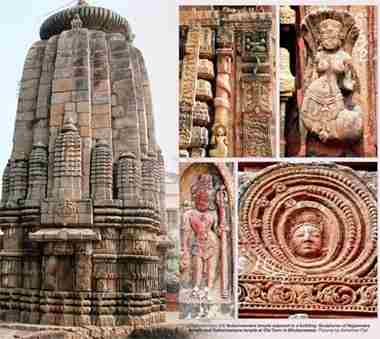From architectural splendour to stunning pilaster motifs, the 10th century Subarneswara and Nageswara temples situated in the Kotitirtheswar lane of Old Town have every characteristic of becoming a prominent heritage site.
 However, lack of concern of authorities and even the public, has led to the neglect of the beautiful monuments.
However, lack of concern of authorities and even the public, has led to the neglect of the beautiful monuments.
The temples are located on the left bank of the Lingaraj west canal. The Subarneswara temple is believed to have been built by the kings of the Keshari period.
Built in light grey sand stone, the temple is a perfect example of the mastery of sculptors and architects of ancient times.
The outer wall of the monument is adorned with small temple shaped pillars.
Similarly the Nageswara temple that stands opposite to it is decorated with mystic creatures and figurines carved on the pilasters that add to the ornamentation of this 10th century structure.
Striking sculptures of snakes and demi-gods representing the snake family are also found on the walls of the richly carved Nageswara temple, which is built, in fine-grained ochre sand stone.
Some local residents have been taking care of the temples where all major rituals and daily worship is carried out.
Both the temples were repaired and restored by the State Archaeology under the X and XI Finance Commission Award.
However, the stones on the Nageswara temple were marked in white paint, which need to be professionally cleaned without affecting the surface of the stone since the marks largely mar the beauty of the monument.
Even a few plants have grown on the dome of the Subarneswara and the local residents informed that cracks on the roof and the outer wall of the temple lead to seepage of water during rains.
Since the sanctum pis below the current ground level, the water from the adjoining canal has led to drainage over flow in the temple, weakening the foundation of the monument.
The canal flowing alongside the temples also needs to be cleaned and a proper path needs to be built to reach the temples that stand without any boundaries around them on an open platform above the canal.
The Kalingan shrines, that were earlier surrounded by paddy fields around it, today face threat due to residential buildings and houses burgeoning on all sides.
Hidden by houses that have been built in the past few years and a number of constructions around, the temples are hardly visible when one stands on the road that leads to them.
The temples that could have been a major tourist attraction are standing insecure with threats from rapid urbanisation.
“Although major renovation work has already been done for the temples, a couple of years back by the State Archaeology, the aesthetics of these beautiful monuments need to be taken care of,” says Sadasiba Pradhan, head of the department of Archaeology, Utkal University.
“After all, none of us or our houses will sustain time, but these centuries old structures have,” he adds.
The monuments need the urgent protection of the State Archaeology before more constructions pop up around them.
“We have been working on undertaking more temples under our protection. But the process may need more time,” said an official at the State Archaeology that is facing a shortage of archaeologists and officers.
Author: Namita Panda | Source: The Telegraph [December 29, 2010]





